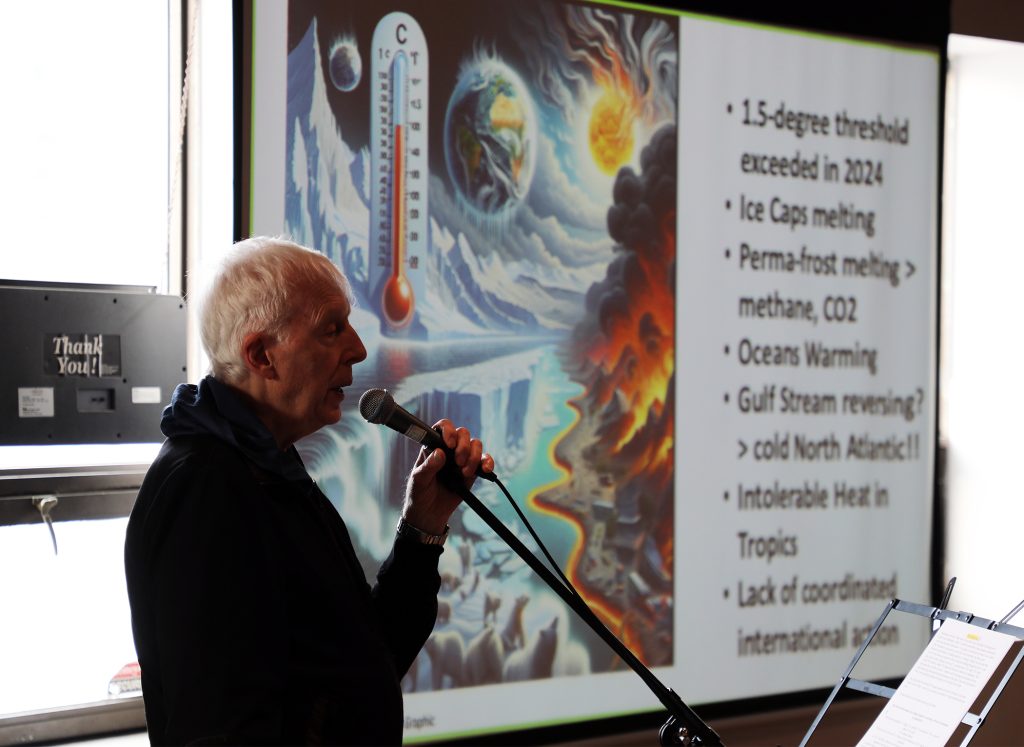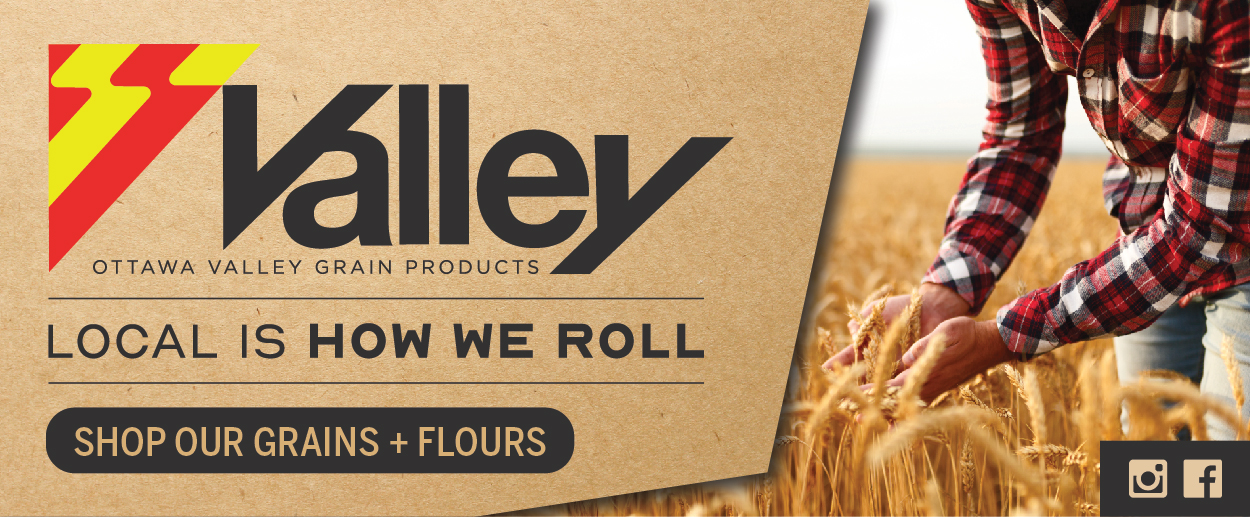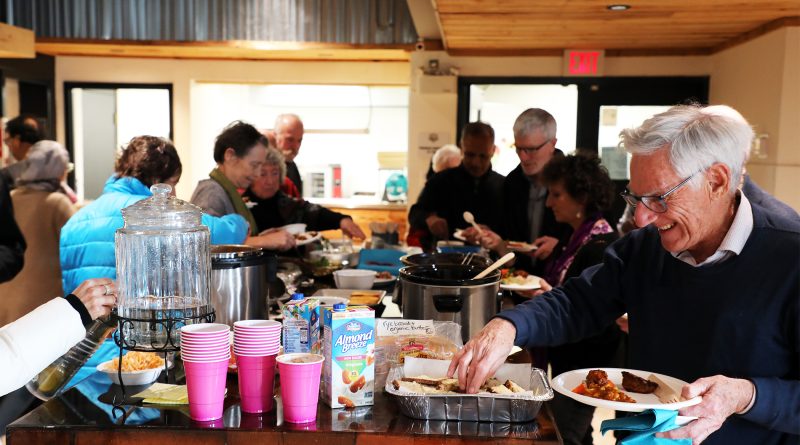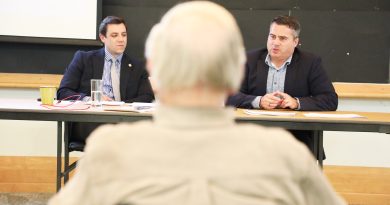Deep Roots launches plan to save world
By Jake Davies - West Carleton Online
CARP – Last week (April 8), roughly 30 people gathered around a communal table filled with great recipes made with local food to share in potluck style, and following dinner plotted to save the world.

On Tuesday, April 8 Deep Roots Food Hub (DRFH) hosted a community potluck at the West Carleton Amateur Sports Club on the second floor of the Carp arena before hosting its annual general meeting. While the DRFH community from West Carleton, Kanata and beyond enjoyed some wonderful homemade meals, DRFH chair Dr. Barry Bruce shared his plan to lower rising global temperatures and save the world from the humans who call it home.
While people were still eating, Bruce headed to the microphone, complete with a slideshow, and shared details of the work ahead.
“We all have a problem,” Bruce told the crowd. “It’s huge, it’s global, it’s existential. We’ve known about it for years. It’s climate change. We had our first full year of 1.5-degree Celsius global warming in 2024, much earlier than predicted. In 2015, the Paris Climate Accord stressed the urgency for countries to work together to prevent going over the 1.5-degree threshold by 2030. Countries have not worked together; we’ve exceeded the 1.5-degree threshold; and it seems unlikely that countries will work together even though earth is on course to be much less inhabitable from now on. Countries probably won’t work together, but people can.”
Bruce said, despite the deadly evidence, there is a way forward.
“Unchecked, climate change has a high probability of hurting everyone present in this room today, with a distinct possibility of causing the extinction of the human race,” Bruce said.
Bruce says the planet is at the point that stopping burning fossil fuel burning tomorrow would not be enough.
“Agriculture could become the big solution if it can be ‘net negative,’ capitalizing on its potential to pull enough CO2 out of the atmosphere to reverse climate change within a few years,” he said. “Human diets would have to become plant-rich to reverse climate change within the required time frame. We’d also have to stop getting many of our calories from processed foods, so we’re not just talking agriculture here, it’s the agri-food system. I believe the people of Carp and surrounding area could start the agricultural ‘net negative’ movement that, to be effective, needs to become a global movement, and it could start here, tonight.”
Bruce says a lot of the problems facing the earth and the humans on it are connected.
“Most of the arable land on earth is already used up, requiring the destruction of forests to supply more land,” he said. “We use most of our crops to feed our livestock, largely beef, returning one calorie for
every 25 put in. It’s getting so hot in the tropics that the jungle that is left is struggling to cope with dryness, intense rains, and the heat. While our livestock is fed and dominates the mass of mammals on earth, more than 800 million people are starving, another two billion are food insecure, and most of the people in the first world, us, are overfed and dying by the millions because of unhealthy diets. Over More than 75 per cent of the soil is degrading, and over the last century has lost most of it’s stored carbon-based life forms – the soil biome – the carbon is still around. It’s just that it’s in the form of CO2, the most important greenhouse gas, and the planet is warming up at an alarming rate.”
Bruce says the key to saving the planet is regenerative agriculture.
“Regenerative agriculture focusses on the health of the soil, and is central to sustainability, universal abundance, and human health,” Bruce said. “Tilling is avoided, at least anything below two inches. It exposes and kills much of the soil biome all by itself. The mycorrhizal net is broken and doesn’t recover for years after a single till. Inorganic fertilizer is avoided. Why would plants feed the microbiome below if it can get fast-food so easily? Herbicides and pesticides are avoided. A local food system would be based on regenerative agriculture.”
Bruce says Canada imports most of the food eaten here over the winter an about 60 per cent of the food we produce is wasted. He adds because of the food supply chain, multiple mediators along the way need to be paid, meaning the farmers who produce the food are paid very little, while the food at the end of the trip is very expensive for the consumers. Bruce says eating meat just isn’t sustainable.
“So why is Sustainable Local Food Systems Everywhere a potential solution to all of the problems mentioned above, maybe even the solution?” Bruce said. “A sustainable local food system would grow food for direct human consumption. Animals grown for meat, dairy or eggs would feed themselves on managed pasturing, a form of regenerative agriculture in itself. The local food system would grow, store and preserve, market, and distribute food locally. The system would rely on the ability of the local population to change its growing and eating habits, and that would require considerable education, training and experimentation. The avoidance of waste would be a very important activity. A special kind of grocery store would be needed, that carries mostly locally grown produce, adapts to the fact that some customers are economically challenged, sources regenerative produce that can’t be grown locally, doesn’t sell anything that is highly processed or knowingly unhealthy and provides education and training opportunities.”
Bruce says in the Carp area, a sustainable local food system would have to account for winter as well and that’s where the DRFH’s off-grid food cellar comes in. The cellar is capable of holding about 70,000 pounds (31,751 kilograms) of produce “keeping it fresh and available all winter.”
The cellar opened in 2020 but has never held more than 7,000 lbs. (3,175 kg). Bruce says Sustainable Local Food Systems Everywhere could potentially start reversing climate change returning humans to a “safe zone” within six years and feed all humans on less than 20 per cent of the land currently used by agriculture.
Bruce then shared a draft business plan with the group.
“This year, 2025, we’ll use medium-scale agriculture techniques, suited to 40 or more acres of land, to grow on 10 acres of land that we’ve rented on the Tommy Dolan Parkway,” he said. “That sort of scale requires mechanization, and we’ve got a ‘60s vintage 31 HP diesel tractor, graciously donated by Roger Stone, as well as a couple of cultivators, a subsoiler that we’ve used already on very compacted soil, a bush hog, and a dump-trailer. We’ll experiment with growing flint corn, beans, winter squash, lentils, and root vegetables of all sorts, tomatoes and summer squash, daikon radish, some small grains and potatoes. Nothing will be destined for the fresh market except for what volunteers take. We’ll also invest in more equipment, ideally vintage, not huge and expensive, like discs and harrows. It would be great if we could purchase a seed drill and harvesting equipment locally, and maybe some of you could help us to find these things. We’ll use open pollinated seed and save some seed for planting in subsequent years.”
Bruce says the project will expand by 20 acres at the same site in 2026, and to 35 acres in 2027.
“We would have accumulated roughly $400,000 in cash if, and I realize it’s a big if, we can manage mostly with volunteers for these first years,” he said. “In 2028, we’ll use a mandate-linked for-profit corporation to grow ever-increasing amounts of produce, to store and preserve it, to market and distribute it, and to build toward a system that in 2031 would have the capacity to feed 3,000 people for the year. That would require six million pounds of food roughly, to generate roughly $9 million dollars in retail sales income, on about 750 acres regeneratively farmed by 15 to 20 farmers.”
The DRFH has already scheduled another community potluck for Tuesday, April 29 back at the West Carleton Amateur Sports Club (3832 Carp Rd.) where next steps will also be initiated.
“The last meeting sets the stage for the meeting on April 29 when we’re going to enable very specific actions to take place in 2025 that will lead to a Carp Sustainable Local Food System prototype by 2031, or earlier if we can,” Bruce told West Carleton Online after the meeting today (April 16).
The potluck is free to attend (just bring a recipe), but registration is required to help organize the event. For more information, or to register for the April 29 potluck, click here.











